
|  |

|  |
 e-mail: khokar1960@gmail.com Kathak Kumbha! (Part 1) Photos courtesy: Kathak Kendra March 30, 2025 The history of Kathak is too convoluted to elaborate in one column. It needs a book, which is underway for the last ten years because there are no good books on Kathak in English with empirical evidence and clear history. In Hindi, and dialects many abound but no standard work in language of the world - English. Mine is already 500 pages and not finishing! Problem is, even if we give a bag with wheels to carry it, as it'd be 3 kilos, who will buy for 3k or 5k it'd cost? Today's India is on Facebook not reading real books. Insta-nt gratification! Fortunately, all our books sell internationally and on Amazon. Last week I was shocked to see my own book on Rupa's Eternal India Series: Classical Dance, published 20 years ago, priced then at ₹299 only selling now for Rs.11,999! The seller sitting over that last copy left, will have blessings of Saraswati, even if I don't get to see any Lakshmi. Kathakaars and Kathaks history also lies in provenance, platforms of patronage and public perception. If devadasis were treated poorly in South, then the courtesans of North were plain used and abused, going by the social contexts of an illiterate Central and North India of yore. The colonial masters didn't help matters much by calling all our dance forms Nautch and degrading it further to world's oldest profession. Post independence, it took many gurus and institutions to help reinstate Kathak to its present status and glory. Kathak Kendra under the Sangeet Natak Akademi was created innocently. It so happened that one lady Sumitra Charat Ram, wife of Lala Charat Ram, one of the sons of Shriram (Aggarwal) was fond of literature and the arts. She brought old world charm and U.P. culture to la la land, that was Delhi. On eve of independence, Delhi was a small town of 40 lakh people, mostly in the walled city, Chandni chowk area. The trading community - the Jains and Gargs; Guptas and Aggarwals - ran the city retail. Add, many illustrious families like the Shriram (creators of Bharatiya Kala Kendra and Kamani hall) and sugar barons like Narindra Lal (wife Kamla Lal and daughter Rupa Lal created the Natya Ballet Centre), who enhanced Delhi's cultural scape. Sangeet Bharati was the first such institution created in Mandi House (between Triveni and Shriram Centre) in the late 1930s. To celebrate the arrival of independence, an all-night music programme was hosted by the Shriram family in their mansion (now the Hindustan Times building on Curzon / Kasturba Gandhi Road in Delhi C.P. area) where Pt. Ravi Shankar, ustad Bismillah Khan sahib and Shambhu Maharaj gave an impromptu performance. That was the seed for Charat Ram family to start the Bharatiya Kala Kendra. The Bharatiya Kala Kendra or Shriram Bharatiya Kala Kendra was the home to Kathak Kendra. It so happened that when India became independent, there were really no institutions to teach Kathak. Music, there was the Gandharva Mahavidyalaya created first in Amritsar itself, with branch in Delhi later. The SNA or Sangeet Natak Akademi was created by an Act of the Parliament in 1954. To augment Kathak teaching it gave monies to SBKK to run classes as Sumitra Charat Ram had already got the doyen Shambhu Maharaj to teach there informally. His uncle Achchan Maharaj was already teaching at Sangeet Bharati. He died suddenly in 1947, leaving his family distraught so a 14 years old son - Brij Mohan Mishra (Birju Maharaj) - started teaching to sustain the family. Such is the stuff history is made of. (Read more in SBKK - A History of Delhi Artistes by yours truly, Roli, 1998!) SNA was then under Nirmala Joshi, its first dynamic secretary. Those days, the chairperson was a figure head, often a neta or later, abhineta! Nirmala Joshi was ousted by her own trusted aides who made her sign certain slips that led to audit issues and she had to resign. SNA had become part of Delhi Darbar culture and politics. How can ANYTHING in Delhi (or India) be otherwise? We are a very active race with petty politics!  Manjushree Chatterjee looking at poster Fast forward to today 2025. SNA has an active and hands-on chairperson Dr. Sandhya Purecha, who is both smart to games people play and artistically knowledgeable too. Being an academic, she brooks no nonsense and is no push-over either. Under her and Raju Das' guidance, the director of Kathak Kendra, Pranaame Bhagwati put up a mega Kathak festival from 21-26 March, in Delhi: 150 participating dancers; nearly 50 scholars; 18 sessions in all plus plus plus - that's a book fair, food fair and dance fair. A mela of Kathak, it was! First of all, let's contextualise the form. Post independence, there's been a resurgence to get it acceptance in society. The Partition of India also didn't help because many good musicians and dancers got displaced. Independence also meant that many courts which supported art activities - especially dance and music - like Lucknow, Jaipur, Lahore, Benaras, last being a hybrid of all, Raigarh - got marginalised once the kingdoms went and when the Privy Purses to prince and princess were abolished by Indira Gandhi in early 1970s, the royal folks got a reality check! They had lots of wealth but no money. Liquidity of assets was an issue. Post independence also brought in new patrons. The lalas and the babus. One had money, other had power. In Delhi, initially, this marriage worked for a decade from 1950-60s. The lalas were an indulgent lot, liked good things in life, supported education and culture, built colleges and lived a life of luxury. Sarkar was low key, trying to be socialistic and looking out for the last man on the totem pole. So, slowly institutions were set up like Kathak Kendra, MSU Baroda, the first university offering dance at graduate level and many other cultural and educational institutions. Fast forward to today: Kathak Kendra is in a modern building in Chanakyapuri diplomatic area. The building design is ghastly, neither fit for dance nor work. Next door is UNESCO and what a shining model of design and architecture. Same size of plot, an Indian sarkari agency building an ordinary art institution and next to it, world's best talent creating a milestone. Private versus govt. or professionalism vs. unprofessionals. 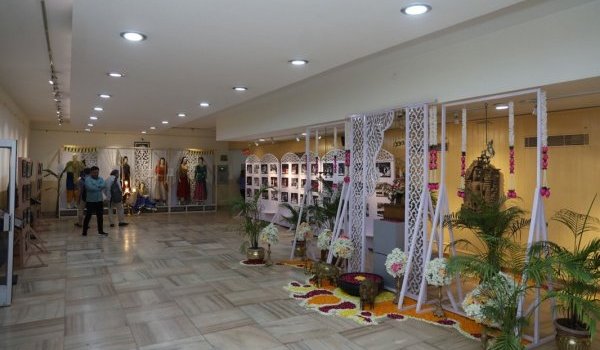 Entrance 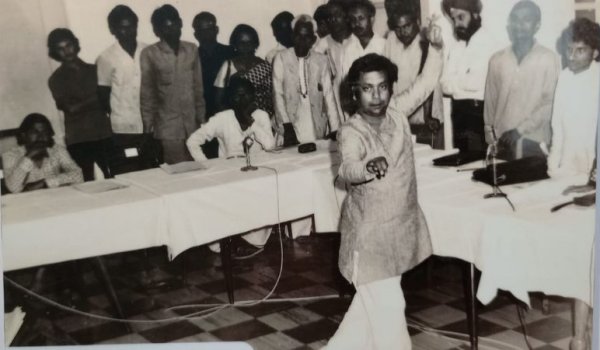 Photo of young Birju Maharaj at exhibition in foyer 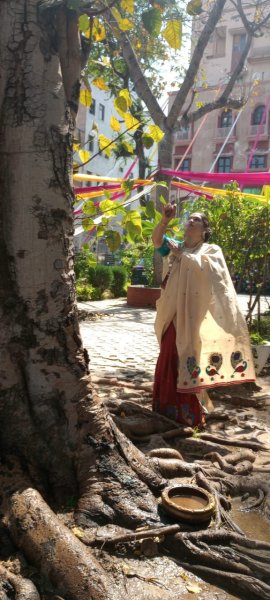 Pranaame Bhagwati In her introduction on the first day first session, which was on literature of Kathak (mostly books and its authors) she detailed printing process from old days to current, since her family had a press she shared on stage. She is as is where is basis. What she knows she knows what she doesn't she doesn't pretend. Delhi will shape her up; Delhi air is like that! Chief Guest, a local vocalist, was one and a half hour late. Criminal. In metro India, time is precious. We reached from all over India and this vocalist couldn't reach from one point in Delhi to another? An apology would have helped... Small things show how evolved a person is. Mere skill in art is not enough. She just said the car sent to fetch her was late. Wow! My flight from Bangalore was late too but I was first in the hall that morning. Punctuality shows professionalism. Start early; don't blame traffic. That won't change for anyone. How do we reach on time for trains or planes or places abroad? The first speaker Rajeev Indramani Jha was trained under Bombay film dancer Gopi Krishna. One may say Benaras gharana and all but he won acclaim in and because of Hindi films. Period. University types can be bookish. He eulogised Dr. Puru Dadhich, the octogenarian. He then elaborated on his book KATHAK DANCE EDUCATION. On mode and model of research. Diversified, institutionalised. Evolution of GSP (guru shishya parampara) and gharana to coming of the Kathak Kendra. Nothing LITERARY. Just rattling of facts and figures. He sounded anti-gharanedar! One can praise the NEP 2020 without having to put down traditional knowledge systems. He spoke on the four purshaarthas and Dharma being holistic. Artha as vocationalism; Kaam being aesthetic; Moksha. He also wore a second hat of Psychology of Education and desired that Kathak Kendra should get UGC recognition. Next, he mentioned Kapila Vatsyayan's scholarship and the concomitant gap in research. He concluded with basic fundamentals or the applied ten-point program. How to devise: 1.Pre search module. 2.Pre PhD 12-16 credit. 4.Research problem Selection was a special feature. 4.Plagiarism and ethics concerns are central too. 5.Publications 6.Papers 7.Open Defence 8.Viva voce 9.Post doctoral. And on to ten. QED: Today Kathak is more than gharana! The next speaker on day one morning session was Dr. Maya Rani Tak: her book- Ethasik Paripeksh Kathak, by Kanishka publication was tabled. It is "a research on what we think as minor issue actually can be a major subject ". Definitions. Grammar and vernacular. Boring history lessons... Sweet voice. Pracheenta ko pramaan mangta mann gadit nahin (history needs proof... Not made-up stories). She shared that in Jati Granth, caste not art was focused upon. Dhawla Jati (in Churu district) all 3 are mentioned as kathiks. There are as many as 123 Sub sects. WHAT IS KATHAK? KARAM VARG (professional class/ ability) best not caste or title, was the conclusion. Shastric is one with evidence, she enunciated. KushiLov... Those who helped the sons get the due. As in the story of Ramayana. According to her, Gharana was sacrosanct - as a laxman rekha. The mediaeval age, read Muslim courts, brought in changes. Kathak had Hindu origin but under Mughal courts became a market art, as aim was entertainment not EDUCATION or propitiation. Vasna. Naachna. Nachaniya. Till Wajid Ali Shah of Awadh, Lucknow rule, Rahsya became Raas or vice versa. Many gurus were hosted, she held, in the courts by way of patronage. He was a lighthouse for artistes. No wonder the British under General Outram (played by Sir Richard Attenborough in Satyajit Ray's Shatranj Ke Khiladi or The Chess Players) threw him out for wasting time on Raas and usurped his Kingdom, banishing him to Mattiaburj in Bengal. Tak said: "Move on with the times." But she didn't keep an eye on the watch, despite saying there's yet another speaker. Nandkishore Kapote of Pune was direct and down to earth despite wearing royal clothes! He sounded earnest. He shared his humble background as an average B. Com student who came to Delhi to learn Kathak from the King of Kathak, guru Birju Maharaj in 1978. He shared how one day he was introduced by his guru, to fellow Puneite, he didn't know of or ever met, Bhimsen Joshi. He was mesmerized by the friendship between Maharaja of music and Maharaj of dance. Nandkishore Kapote shared his books in a soothing manner. He obviously loved his subject, that's his guru. Evening dance show at Kathak Kendra premises started one hour late! Tuning instruments took another 20 minutes. Vishal Krishna got the honour to start the 3-day evening shows at Kathak Kendra premises. He is more drama than dance! His material is same and predictable. Dhoom dham se Dhamar then dhamdham fall on stage then bring a paraat (brass plate) and do thump thump and then go jump jump! Next time someone please give him swords to dance upon, since in old photos, one sees that and he espouses much on stage of such tradition. Namrata Rai next gave relief and it was nice to see some clean dance, strong coloured costume. On the tabla, S. Maharaj and singer Dadhich with Dhiraj's flute made for a wholesome soundscape. In Tihais, she showcased Gopi with Krishna laddi, ending with the asthapadi Priye charu shile...but linear. Young people need to understand depth of poetry. Jayadeva smaran dovetailed to baithaki andaz to link to Lucknow gharana. Nilima Adhye of Pune was clinical and cerebral. In Shiva bhole.... all age group on stage looked a hodgepodge. A good opportunity wasted, 500 best people in Delhi dance circle were there to witness. 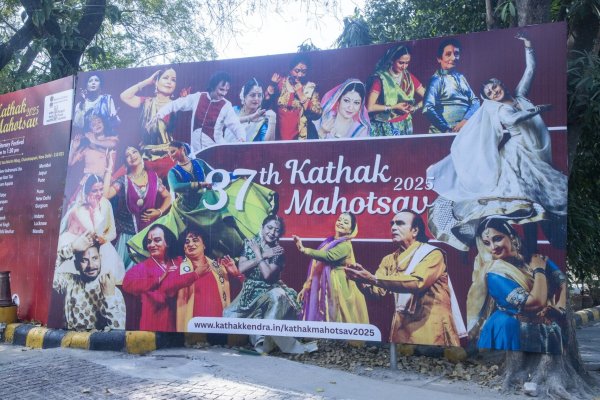 Day 2 morning LITERATURE component started again 45 minutes late. Chief guest Dr. Balram from Odisha, a teacher at heart, gave a garbled introduction to what's classical and other definitions. Tulsi charnamrith bit was zero content link to Kathak. Guru Roshan Datye was the first speaker of note and what a direct, clear and worthy scholar. She elaborated on Kathak's connection to architecture and sculptures. She stated pracheen means something of value. Kathiyas/ kathiks were referred to in Mahabharat too. That's why the title of her first book: Kathak Adikathak. She shared the uniqueness of Saanchi too with links to legendary Amrapali. She chided students: DON'T JUST CLAP: I will speak but you must follow! Best visually driven lecture with Abha demonstrating, it was first rate. She referred to the Jain mandir complex in Khajuraho. Tourists often visit main ones starting with Martanda, where puja is still offered to a huge Shivlinga but the Jain group of temples (see Devangana Desai books and mine by Rupa & Co..1995) are magnificent and bit behind the main streets. She showcased rare photos of Dilwara temples where 4 hands are depicted to show movement. Like karana. Also, Krishna roof flute depiction - vrishshchikaran. Then Brahmara (cross legged). Shramaka. Chittorgarh 16th century link from 10th -16th. The classic picture she ended with was of an Abhisarika nayika who is frozen seeing a snake... Bhujangasana. Popular cultural personality of Delhi, Shovana Narayan next focused on her 7 decades of work. Her post retirement (she was a respected IAAS, audits and account officer) work in documenting history of Kathak in unusual settings of her native Bihar where in Gaya there's Kathak gaon. Why named so? Because here "Kathak rehte. Naach gaan". She found them in a few villages and they were given land grants MAAFI LAND. Grants. No tax. Then, social structure needed examination. U.P., Bihar different than Rajasthan. Caste? Madhya level. Went where? Ayodhya. Lots settled there and still perform. Kathak talab provenance. Land recordings led to social systems. There were 2304 according to William Crooke's census of 1892. Prof. and much loved vidwan Bharat Gupt was the last speaker "between lunch and rasa anubhav!"A dilemma what to partake, he joked. Here's a first rate all-rounder: A Delhi University English professor who taught at Shyamlal College, Shahadara for 30+ years and north India's best Natyashastra expert. Current Chair of NSD and trustee IGNCA. Plus, plus, plus. Both speakers gave visual proof and historical. He said, "Classical is shastra linked. Lakshana Grantha is important tool to understand Karana too." NS (that's Natyashastra) observed and continued then it can be dubbed classical. Prayog is a separate historical evidence." "Fundamental definitions are crucial like Pindi mistakenly called group dance. It is not. It means: devta ko utara in body/ pind (village in Punjab)." Natya are different forms, so transition of performance mode from 12th century changed from public discourse...to temples and courts .. to stadiums now. "So, the question arises what's your new story. And whose? Can't make realism. V have film for that. But not an art form. How to take it forward?". One way is PURANA. Take lesser known forward. Full material. Or like in the Mahabharat there's the Yaksha with ten questions. Basically, he wisely concluded: Newness in theme, Material is same. Day 2 evening show was inaugurated by veteran guru Puru and Vibha Dadhich. Vocalist Vajpeyi from Lucknow, with dark long mane, did the honours. Kathak Kendra Director spoke about archives / display at Kamani. 3 artistes were platformed. Nayantara Parpia, Singapore based but hailing from Pune and student of Yogini Gandhi, depicted Jannini, the mother Earth, mentored by Parwati Datta. Tabla was by Pune talent Charu Datta. Ashish Gangani on pakhawaj, Sarangi Sisodia. Her Ganga stuti was based on Sri Adi Shankaracharya's Ganga stotram. Set to raga Bhog, it was stately. Dhamar had a dress or jewelery malfunction! Earrings got stuck in Chunni, making it difficult for her to move arms freely. She took it as a sign of good luck because whenever that happens the show goes well, she shared. Tukda was adroit then, a mishra jati paran. Hori in end written by Anita Singh lacked finish. 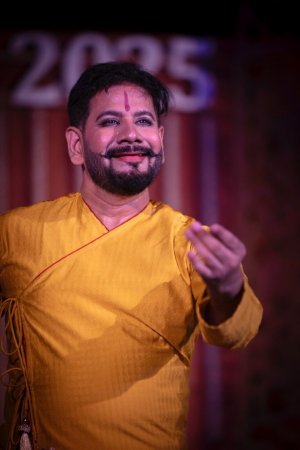 Murali Mohan Kalvakalva Next, Murali Mohan Kalvakalva literally set the stage on fire. He was supported by excellent music that set the stage for the opening homage to Ganesha, Eka dantam. Murali is a natural on stage and engages well and proceeded with a tihai that was international in flavour. Next the Radha Krishna cameo was sorta too tame but sitar was excellent. Murali has the best of all the worlds: A Telugu, born in Gujarat, settled in Bangalore living in Bangkok. Having started with Ganesha then doing Shiva Nataraja, then Krishna, end with Ram... Anup Jalota song, Kabhi kabhi bhagwan ko bhakto se kaam padde... He brought the house down with his offering. He made Bangalore brand of Kathak shine in lion's den, that's Delhi Darbar! Senior guru Nandini Singh is a gracious lady and good performing artiste. Her group however was without much impact. In her sharing on film shown on the last day, she lamented that her previous two generations of students didn't get patronage. With teary eyes she thanked the Kathak Kendra for giving her third generation students a chance to dance. 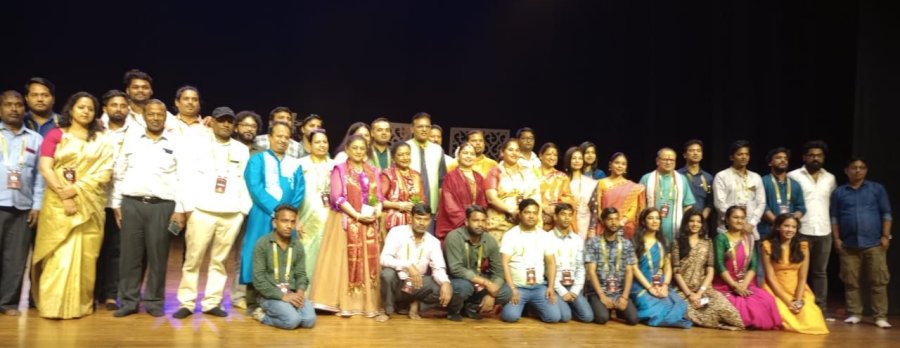 Staff and team of Kathak Kendra that undertook the festival Kathak Kumbha! (Part 2) 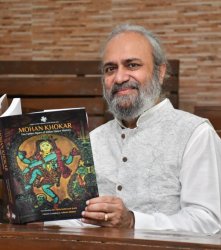 Critic, connoisseur, historian, author, artivist, archivist, administrator and more - editor, columnist and mentor Ashish Khokar remains true to his muse. More on attendance-india.com Responses * What a detailed and insightful coverage with such minute observations and clarity, along with so many interesting pieces of information. I especially loved how you included the story behind the rise of the Kathak empire in Delhi, as well as how SNA's culture evolved over time, influenced by various sources. There were so many pieces of information I didnít know before! Looking forward to your next part! - Shila Mehta (April 2, 2025) * Very detailed article, honest observations and a lot of knowledge about Kathak has been shared. Helpful for all those who are willing to learn, albeit not insta-nt learning! - Rashmi Singh (March 31, 2025) Post your comments Please provide your name and email id when you use the Anonymous/blog profile to post a comment. All appropriate comments posted with name and email id in the blog will also be featured in the site. |